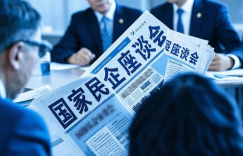
What we are going to talk about this time is the reset of industry and wealth caused by structural changes. Let me first talk about a surprising good news, that is, China’s foreign trade scale has hit a new high again.
According to the import and export data for the whole year of 2024 recently released by the General Administration of Customs of China, China’s total import and export volume reached 43.85 trillion yuan, a year-on-year increase of 5%; while exports are even more impressive, with the total export volume in 2024 reaching 25.45 trillion yuan, a year-on-year increase of 7.1%, and the share of global exports continued to increase to nearly 16%. Both the total import and export volume and the overall export scale have hit historic highs. Not only that, the trade surplus for the whole year of 2024 reached an unprecedented 7 trillion yuan.
Objectively speaking, although there are factors such as domestic companies rushing to export and foreign companies preparing stocks in advance, the data is still really eye-catching.
At this time, some people may ask, why are foreign trade and exports so hot, and the data is so eye-catching, but I don’t feel this warm wind? That’s because, in the current round of wealth reshuffle in the foreign trade field, only some people and some industries have seized the opportunity.
In this reference today, I will take you to deeply analyze the four core trends happening in the foreign trade field. These trends are not only reshaping the industry’s pattern, but also redistributing the flow of wealth, which is closely related to your future. You are also welcome to share this lecture with your friends who are doing foreign trade, so that they can also receive the signal of industrial change.
Trend 1: Product categories have changed dramatically, and the supply chain has moved to the central and eastern regions
Let’s start with the main topic. Let’s talk about the first core trend first. The product categories in the foreign trade field are undergoing tremendous changes.
According to CICC’s statistics, from 2017 to 2024, the proportion of intermediate products in China’s total exports increased from 42% to 46%, while the share of consumer goods decreased from 36% to 33%, and the share of capital goods decreased from 21% to 19%.
The intermediate products here are intermediate products in the production process, including raw materials, parts, semi-finished products, etc., such as steel, automobile engines, circuit boards, etc. Consumer goods are final products that people buy and use, such as home appliances and clothing; capital goods are various durable equipment used for production and transportation, such as machine tools, transport trucks, ships, etc.
The proportion of intermediate products continues to rise, while the proportion of consumer goods and capital goods continues to decline. This trend means that China is exporting more semi-finished products.
Behind this, it corresponds to the wave of Chinese companies going overseas. Due to factors such as the trade war, the global industrial chain began to restructure after 2020. Chinese companies have chosen to go overseas and gather in Southeast Asia, Mexico, South America, the Middle East and other places, which has also profoundly changed the domestic industrial distribution pattern.
The previous pattern was: companies purchased raw materials from the central and western regions, produced final products in the eastern coastal areas, and then exported directly overseas.
Now, the pattern has changed: companies go overseas to other countries, while the supply chain remains in China, so they purchase semi-finished products from China, and then produce and sell them in overseas factories. That is, “both ends are outside, and the middle is inside.”
Under this trend, companies in the supply chain are actually facing a choice in order to maximize cost savings – either choose to go overseas together or choose to migrate to coastal areas.
At present, supply chain companies are more likely to choose to migrate eastward, more specifically, to the central and eastern regions, with the goal of finding cities with the lowest costs for production.
In fact, the eastern and central regions each have their own advantages. The advantage of the eastern region is that the industrial clusters are developed and close to the port, while the advantage of the central region is that the cost of raw materials, labor, land, etc. is cheap, but there is an additional logistics fee to transport the goods to the port.
Therefore, based on the respective advantages of the eastern and central regions, I judge that the following three trends will appear in this large-scale migration of the supply chain:
First, light industrial export companies, such as clothing and food, will migrate to the central region because the cost of labor and land is lower; while heavy industrial export companies, such as ships and wind power equipment, will migrate to the east because logistics and supporting facilities are more complete.
Second, labor-intensive export companies will migrate to the central region, while technology-intensive export companies will tend to move to the east.
Third, many companies in the east will also choose to move to the central region. For example, many factories in Foshan and Dongguan have moved to Hunan.
It can be inferred that the central cities in the central region are very likely to gain the biggest dividends in this export supply chain transfer. In addition, the country is now making every effort to repair the canal, and the logistics and transportation costs of the central region’s exports through the east will also be fully reduced. Therefore, cities such as Wuhan, Changsha, Wuhu, Shangrao and other cities in the central region are expected to gain greater dividends in this round of supply chain transfer by virtue of their own location advantages and continuously improving transportation conditions.
Trend 2: The “Southward Shift” of the Center of Grain of Foreign Trade Exports
The second core trend that is happening in the field of foreign trade is the change in product destinations.
Before 2023, the United States and the European Union remained in the first and second positions among China’s export destinations for many years. But after 2023, China’s exports to ASEAN, that is, the Association of Southeast Asian Nations, accounted for more than the United States and Europe, and this trend is still expanding.
The reasons behind this are relatively complicated. Let’s briefly talk about a few:
For example, because the United States and Europe have added high tariff barriers, a large number of Chinese companies have chosen to go overseas to ASEAN countries, which has brought about a continuous demand for the purchase of semi-finished products, raw materials, and parts, driving China’s exports to Southeast Asia.
For example, most countries in Southeast Asia have entered the “young and middle-aged period”, with a high proportion of young people, which has brought sufficient demand, and the rise of China’s cross-border e-commerce has also driven Chinese consumer goods into the Southeast Asian market.
For another example, ASEAN countries have successively started their own industrialization process, vigorously developed new industries, and greatly increased demand for related industrial products in China.
In short, under the influence of these factors, China’s exports to ASEAN will continue to grow in the future, while exports to the United States and Europe will continue to decrease. Under this trend, the focus of China’s foreign trade exports will “move south”.
Under the transmission of the trend of “southward shift” of the focus of foreign trade exports, the foreign trade pattern between cities will also usher in a wave of reshuffles. Specifically, the opportunities in provinces such as Guangdong and Fujian are more worthy of your attention. We can choose several better target cities in the two provinces.
For example, Guangdong and Shenzhen’s cross-border e-commerce is very developed, and Guangzhou has the blessing of the Canton Fair and the status of an international shipping hub. These two cities are undoubted choices, but they are also highly competitive and costly. I would rather recommend Dongguan, which is a manufacturing base, especially for the export of electronic products. Foshan of the same type is also good, but Dongguan is more prominent.
Then there is Fujian, where Xiamen is an obvious good choice. In addition, I recommend Quanzhou, which relies on traditional foreign trade industries such as textiles, clothing, and footwear to expand the Southeast Asian market. It has more advantages than the provincial capital Fuzhou.
Data shows that Shenzhen’s total import and export volume in 2024 will reach 4.5 trillion yuan, which is the first time it has exceeded Shanghai since 2015; during the same period, Dongguan’s foreign trade dependence remained above 120%, and Xiamen’s exports to RCEP member countries, namely the ten ASEAN countries and Japan, South Korea, Australia, New Zealand and other countries, increased by 21.3%, and Quanzhou’s cross-border e-commerce import and export volume also exceeded 100 billion yuan, showing the strong momentum of the southern channel city.
Trend 3: The technological content of products continues to increase
Next, let’s talk about the third core trend happening in the foreign trade field, which is the change in the technological content of products.
A highlight of the export data in 2024 is that the “technological content” of export products is constantly increasing.
In 2024, the export of electromechanical products increased by 8.7%, with a scale of more than 7 trillion yuan. Among them, the export of integrated circuits increased by 18.7%, the export of flat panel display modules increased by 18.1%, and the export of ships and marine engineering equipment increased by 60.1%. China’s wind turbine exports increased by 71.9%; photovoltaic products exported exceeded 200 billion yuan for four consecutive years; and lithium batteries exported 3.91 billion, a record high.
At the same time, more new products with high-tech attributes are accelerating their export, such as electric vehicles, 3D printers, and industrial robots, which have achieved growth of 13.1%, 32.8%, and 45.2% respectively.
According to rough statistics from existing data, high-tech products account for more than 60% of the total export volume, about 15 trillion yuan. This figure was 30% in 2014 ten years ago, and only 6% in 2004 twenty years ago. It has increased tenfold in twenty years.
This is actually the transformation and upgrading that the top leaders hope for, from a simple OEM processing industry to a high-tech industry, from exporting labor-intensive products to exporting technology-intensive products.
There are so many data listed above. What I want to tell you is that the trend of technology dividends continuing to expand in the field of foreign trade will not change, which will obviously bring about a reshuffle of classes: companies and entrepreneurs who master hard technology and real technology will get the maximum dividends, and individuals who devote themselves to it can also get a share. Most people who earn wages through simple repetitive labor may face the risk of unemployment in the future with the advancement of technology. People who master scientific and technological productivity will have the opportunity to leap into a higher class. Therefore, devoting oneself to, investing in, and investing in technology dividends are also practical in the field of foreign trade exports.
Trend 4: Re-export trade is fading
The fourth core trend happening in the field of foreign trade is that re-export trade is fading and local market mining is on the rise.
There is another very noteworthy point in the export data in 2024, that is, re-export trade is fading.
Since the Sino-US trade war started in 2018, the global supply chain began to be restructured in 2020, and the largest wave of Chinese companies going overseas appeared in 2023. During this six-year period, Chinese foreign trade companies have formed a trend, that is, to choose a third country for re-export trade, or to go directly to a third country for production, in order to avoid the high tariffs of the United States and Europe, reduce costs, and ultimately export products to the European and American markets.
However, some phenomena in 2024 suggest that this idea of enterprises is fading:
For example, the development of Vietnam’s electronics industry has driven China’s silicon exports, and the motorcycle industry has driven China’s inner tube exports. Mexico’s furniture and home appliance industries have driven China’s related parts exports. Indonesia’s nickel mining has accelerated China’s base metal and smelting equipment exports. The development of the lithium battery industry in South Korea and Eastern Europe has driven China’s exports of lithium hydroxide, artificial graphite and other intermediate products.
At the same time, these fields are also industries where China’s overseas investment and corporate overseas expansion have greatly accelerated. Large electronic companies such as Luxshare Precision, Pegatron, and Wistron are constantly expanding their production investment in Vietnam. For example, in the total sales of retail consumer goods of cross-border e-commerce in Guangzhou, the demand from Southeast Asia accounts for nearly 40%.
These phenomena all imply that the purpose of enterprises’ overseas exports is shifting from the original “avoiding high tariffs” to “exploring local markets”. Many overseas enterprises have found that instead of exporting to the United States, it is better to sell directly locally and deeply explore the local market.
All of this will bring about a reshuffle of the supply chain in a considerable sense: in the past, products were created to adapt to the consumption habits and production needs of Europeans and Americans; but now the road to exporting to Europe and the United States will be more difficult, and more market demands from developing countries will emerge. For enterprises, if they want to deeply cultivate these countries, they must create products that are adapted to the culture, religion, customs, consumption habits, and production habits of these countries, and these will trigger a reshuffle of the supply chain.
This is the key to our data analysis: we don’t want to see the results, but to deconstruct the process, and see trends and opportunities from the deconstruction.



